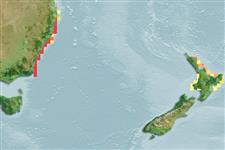>
Eupercaria/misc (Various families in series Eupercaria) >
Labridae (Wrasses)
Etymology: Achoerodus: Greek, a = without; also with the meaning of copulative particle = with + Greek, choiros = pig + Greek, odous = teeth+B103 (Ref. 45335).
More on author: Steindachner.
Environment: milieu / climate zone / depth range / distribution range
Ecología
marino asociado a arrecife; rango de profundidad 1 - 40 m (Ref. 26878). Subtropical
Southwest Pacific: southeastern Australia.
Tamaño / Peso / Age
Maturity: Lm ? range ? - ? cm
Max length : 62.0 cm TL macho / no sexado; (Ref. 32186); 33.0 cm TL (female)
Adults are found in coastal rocky areas at depths to about 40 m (Ref. 26878). Protogynous hermaphrodite (Ref. 55367). Oviparous, distinct pairing during breeding (Ref. 205). Max. length for female species (Bernard Yau, pers. Comm., 2000).
Life cycle and mating behavior
Madurez | Reproducción | Puesta | Huevos | Fecundidad | Larva
Pelagic spawner. Monandric species, length and age at sex change = 52.6 cm TL, and 18 years, respectively (Ref. 55367). Oviparous, distinct pairing during breeding (Ref. 205).
Gomon, M.F., 1997. Relationships of fishes of the labrid tribe Hypsigenyini. Bull. Mar. Sci. 60(3):789-871. (Ref. 26878)
IUCN Red List Status (Ref. 130435)
Threat to humans
Harmless
Human uses
Más información
ReferenciasAcuiculturaPerfil de acuiculturaRazasGenéticaElectrophoresesheritabilidadEnfermedadesProcesamientoNutrientsMass conversion
ColaboradoresImágenesStamps, Coins Misc.SonidosCiguateraVelocidadTipo de nataciónSuperficie branquialOtolitosCerebrosVisión
Herramientas
Special reports
Download XML
Fuentes de Internet
Estimates based on models
Preferred temperature (Ref.
123201): 16.3 - 22.9, mean 18.3 °C (based on 28 cells).
Phylogenetic diversity index (Ref.
82804): PD
50 = 0.7500 [Uniqueness, from 0.5 = low to 2.0 = high].
Bayesian length-weight: a=0.01995 (0.00922 - 0.04317), b=2.99 (2.79 - 3.19), in cm total length, based on LWR estimates for this (Sub)family-body shape (Ref.
93245).
Nivel trófico (Ref.
69278): 3.7 ±0.4 se; based on size and trophs of closest relatives
Resiliencia (Ref.
120179): Bajo, población duplicada en un tiempo mínimo de 4.5-14 años (tm=8).
Fishing Vulnerability (Ref.
59153): Moderate vulnerability (45 of 100).
Nutrients (Ref.
124155): Calcium = 18.9 [8.5, 36.3] mg/100g; Iron = 0.446 [0.238, 0.957] mg/100g; Protein = 18.8 [15.9, 21.2] %; Omega3 = 0.138 [0.073, 0.259] g/100g; Selenium = 16.6 [6.3, 39.7] μg/100g; VitaminA = 39.4 [8.8, 216.1] μg/100g; Zinc = 0.744 [0.469, 1.321] mg/100g (wet weight);
